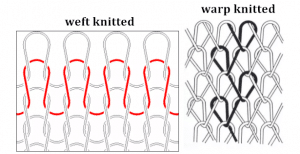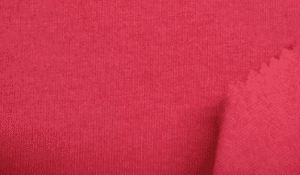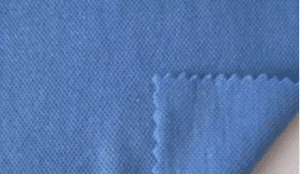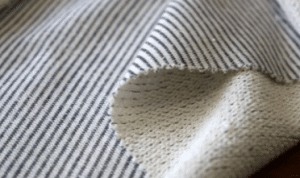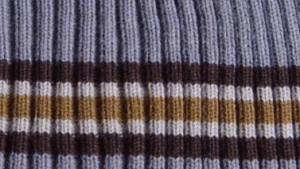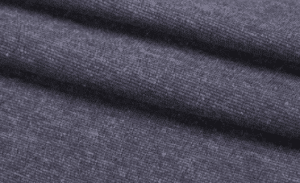What Is Knitted Fabric?
Knitted fabrics are fabrics formed by bending yarns into loops with knitting needles and stringing them together. Knitted fabrics are divided into weft knitted fabrics and warp knitted fabrics.
Weft knitted fabrics are firstly knitted widthwise and are formed by a single continuous yarn tied into loops. Weft knitted fabrics are easier to produce, but they are also easier to fray when cutting.
The warp knitted fabric is usually lengthwise, and its structure is expanded in zigzag, so that it can make the loops form two or more continuous wales. Compared with weft knitted fabrics, it is usually flatter and tighter in structure, resulting in less elasticity and run resistant.
Characteristics Of Knitted Fabrics
(1) Scalability. Knitted fabrics are made of yarns bent into circles and sleeved with each other. The coils have large flexibility up, down, left and right. Therefore, they have good elasticity, fit with the body when wearing, comfortable and convenient, and are suitable for stretching and bending during human movement.
(2) Flexibility. The raw material of knitted garment fabric is fluffy and soft yarn with small twist. There is a layer of tiny suede on the surface of the fabric. In addition, the tissue composed of coils is loose and porous, which reduces the friction between the skin and the surface of the fabric and gives people a comfortable and gentle feeling.
(3) Hygroscopicity and air permeability. Because the loops that make up the knitted fabric are intertwined, numerous isolated air pockets are formed inside the fabric, which has good warmth retention and air permeability. In addition, both plant and animal fibers have a certain moisture absorption capacity, especially cotton fiber, which has better moisture absorption performance. Therefore, wearing cotton knitwear in summer feels cooler and feels no sense of discomfort.
(4) Anti-wrinkle property. When the knitted fabric is subjected to a wrinkle external force, the loop can be transferred to adapt to the deformation when the force is applied; when the wrinkle force disappears, the transferred yarn can quickly recover and maintain the original state.
Common Knitted Fabrics
1. Single Jersey
Single jersey is composed of a continuous looped structure, and the front texture is clearer than the back texture, which is easier to identify.
The fabric has smooth surface, clear texture, fine texture, smooth hand feeling, good longitudinal and horizontal extensibility, and the horizontal extensibility is greater than the vertical extensibility. It has good moisture absorption and air permeability, but it has dispersibility and curling properties, and sometimes the phenomenon of coil skew occurs.
2. Piqué Mesh
The piqué mesh fabric is composed of continuous loops (Knit stitch) and tuck stitch (Tuck stitch), including 4-mode single bead, 6-mode bead, 8-mode bead, twill bead, sports bead, spandex Pearl and so on. Its common raw materials include cotton, cotton-polyester blend, modal, and bamboo fiber.
Double singed and mercerized fabrics, yarn dyed computer large cycle color strips, computer jacquard, computer warp hanging, Modal / bamboo fiber / Tencel / water absorbing and sweat wicking function fiber / antibacterial fiber / organic cotton and other fibers are relatively high-grade varieties of piqué mesh fabrics.
3. French Terry
French terry is a kind of knitted fabric, and it is called fleece after drawing. This kind of knitted fabric is mostly woven by displacement pad yarn, so it is called displacement cloth or sweater cloth. Some places are called terry cloth, and some places are called fish scale cloth. There are many varieties. (Fish scale cloth is named because the back of the cloth is a terry, and some of them look like fish scales) The weight is generally 190g/M2 Between -350g/M2.
4. Rib Fabric
Rib knitted fabric is a knitted fabric in which a single yarn sequentially forms wales on the front and back sides. Rib knitted fabric has the dispersibility, hemming and extensibility of plain weave fabric, and also has greater elasticity.
1×1 ribs look very similar to plain weave fabrics, but the ribs have a looser structure and more elasticity, and generally do not distinguish between the front and the back.
The ribs of other structures, such as 2×2, 2×1 structures, etc., are easy to distinguish from other fabrics due to their special structure.
5. Roma Fabric
Roman fabric is a kind of knitted fabric, weft-knitted, double-sided circular knitting machine. It is also called ponte-de-roma. Roman cloth is a four-way loop, the cloth surface is not flat with ordinary double-sided cloth, and it is slightly slightly and irregular. The fabric has good elasticity both horizontally and vertically, but the horizontal stretch performance is not as good as the double-sided fabric, and it has strong moisture absorption. Being breathable, soft and comfortable to wear, it is used to make close fitting clothes.

